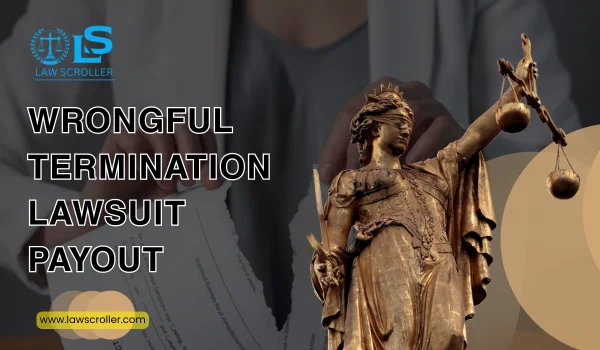Losing a job is hard — but being wrongfully terminated can feel like a punch to the gut. Whether you were fired for reporting discrimination, standing up to harassment, or simply without a fair reason, you might be wondering:
💬 Can I sue? And if I win, how much is a wrongful termination lawsuit payout worth?
The answer depends on several factors — from the reason for your firing to your lost income and emotional distress. Let’s break it down in simple terms so you know what to expect and how to protect your rights.
Background: What Is Wrongful Termination?

“Wrongful termination” means being fired from your job illegally — not just unfairly.
In the U.S., most employment is “at-will”, meaning your employer can let you go at any time, with or without cause. But there are important exceptions where firing someone breaks the law.
Common examples of wrongful termination include:
- Discrimination based on race, gender, age, religion, disability, or sexual orientation
- Retaliation for reporting harassment, discrimination, or illegal activity (“whistleblowing”)
- Violation of contract terms, like firing you before a contract ends
- Punishment for taking protected leave, such as maternity, medical, or family leave
- Constructive discharge, where your employer forces you to quit due to unbearable conditions
In these cases, a wrongful termination lawsuit lets employees seek financial compensation (damages) for what they’ve lost.
Who’s Affected?
Wrongful termination can impact workers at all levels, from hourly employees to executives.
The people most affected include:
- Employees Fired for Unlawful Reasons
If you were dismissed for discriminatory or retaliatory reasons, you may have a valid claim.
- Whistleblowers
Workers who reported unethical or illegal company behavior — and were punished for it — are often protected by federal or state laws.
- Contract or Union Employees
If your employer broke a contract or union agreement when firing you, that’s grounds for a wrongful termination case.
- Workers on Protected Leave
Employees fired while taking or returning from family, medical, or disability leave (like FMLA leave) can also file lawsuits.
What’s at Stake: How Much Is a Wrongful Termination Lawsuit Payout Worth?
The average wrongful termination settlement in the U.S. typically ranges from $5,000 to $100,000, but some cases reach much higher amounts depending on the situation.
The exact payout depends on several factors:
- Lost Wages and Benefits
This includes all the income and perks you missed out on because of the firing — salary, bonuses, vacation pay, and even health insurance coverage.
- Emotional Distress
If your firing caused mental anguish, anxiety, or humiliation, you may be compensated for emotional pain and suffering.
- Punitive Damages
In extreme cases (especially when employers act maliciously or illegally), courts may award punitive damages to punish the employer and deter others.
- Attorney’s Fees and Legal Costs
Many wrongful termination settlements also cover the employee’s legal expenses.
- Reinstatement
Sometimes, instead of or in addition to money, the court may order that you be rehired.
Typical Wrongful Termination Lawsuit Payout Examples
| Type of Case | Estimated Settlement or Award |
| Discrimination or Retaliation | $30,000 – $200,000 |
| Whistleblower Retaliation | $50,000 – $500,000+ |
| Breach of Contract | Amount based on contract value |
| Emotional Distress Only | $10,000 – $50,000 |
| High-Profile Cases | $1 million+ (rare but possible) |
These numbers vary widely based on the state, evidence, company size, and the strength of your case.
Timeline: How Long Does a Wrongful Termination Lawsuit Take?
The process can take anywhere from a few months to a few years, depending on how the employer responds and whether the case settles out of court.
Here’s a simple breakdown:
| Stage | What Happens | Timeframe |
| 1. File a Complaint | You submit a complaint to a government agency (like the EEOC) or directly file a lawsuit. | Within 30–300 days (varies by state and agency) |
| 2. Investigation | The agency or your lawyer reviews evidence, interviews witnesses, and evaluates claims. | 3–6 months |
| 3. Settlement Negotiations | Many employers settle to avoid trial. | Ongoing throughout the process |
| 4. Trial (if needed) | If no settlement is reached, the case goes to court. | 1–2 years |
| 5. Judgment or Settlement Payout | You receive compensation or other remedies. | After the case concludes |
Most cases settle before trial, which saves time and money for both sides.
What to Watch Next: Trends and Case Updates
The landscape of wrongful termination lawsuits keeps evolving, especially as workplace laws and employee protections expand.
Here’s what’s trending:
- More Retaliation Claims
The Equal Employment Opportunity Commission (EEOC) reports that retaliation is now the most common type of wrongful termination claim filed in the U.S.
- Increased Focus on Mental Health
Courts are recognizing emotional distress as a major component of compensation, leading to higher payouts.
- Remote Work and Digital Evidence
With more people working remotely, emails, chat logs, and digital proof are becoming crucial in wrongful termination cases.
- Whistleblower Protections Expanding
New federal and state laws are strengthening protections for employees who report fraud, safety issues, or discrimination.
- Large Corporate Settlements
Some high-profile cases against big companies are setting new benchmarks for wrongful termination lawsuit settlements, encouraging more workers to come forward.
Common Mistakes Employees Make
Many people accidentally weaken their own case. Avoid these pitfalls:
- Waiting too long to act (deadlines can be short — sometimes just 180 days to file with the EEOC).
- Signing a severance agreement without legal review.
- Deleting emails or messages that could serve as evidence.
- Failing to document conversations or events leading up to termination.
Always keep detailed records and consult an employment attorney before taking any action.
FAQs: Wrongful Termination Lawsuit Payout
Q1: How much money can I get from a wrongful termination lawsuit?
There’s no fixed number, but settlements typically range from $5,000 to over $100,000, depending on lost wages, emotional distress, and other damages.
Q2: How long do I have to file a wrongful termination claim?
You usually have 180 days to 300 days to file with the EEOC (Equal Employment Opportunity Commission), depending on your state. Some states allow longer if you go directly to court.
Q3: Do I need proof to win my case?
Yes. Emails, text messages, witness statements, or performance reviews showing discrimination, retaliation, or unfair treatment can strengthen your claim.
Q4: Can I get my job back after a wrongful termination case?
In some cases, yes. Courts can order reinstatement — but most employees choose a monetary settlement instead.
Q5: Do I need a lawyer to file a wrongful termination lawsuit?
It’s highly recommended. Employment laws are complex, and a lawyer can help you gather evidence, file correctly, and negotiate the best possible payout.
Q6: What if I signed a severance agreement?
If you already signed a release of claims, it might limit your ability to sue. But some agreements can be challenged if they were signed under pressure or without full disclosure.
The Bottom Line
If you believe you were wrongfully terminated, you may have a right to compensation — not just for lost income, but also for emotional and reputational harm.
The key is acting fast. Document everything, contact an employment attorney, and file your claim before deadlines expire.
A successful wrongful termination lawsuit settlement can help you recover financially, emotionally, and professionally — turning an unfair experience into a path toward justice and closure.


 Oliver Johnson is LawScroller’s Senior Legal Correspondent specializing in civil litigation, class actions, and consumer lawsuit coverage. He breaks down complex settlements and court decisions into clear, practical guidance for readers.
Oliver Johnson is LawScroller’s Senior Legal Correspondent specializing in civil litigation, class actions, and consumer lawsuit coverage. He breaks down complex settlements and court decisions into clear, practical guidance for readers.